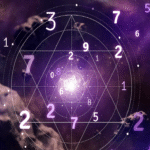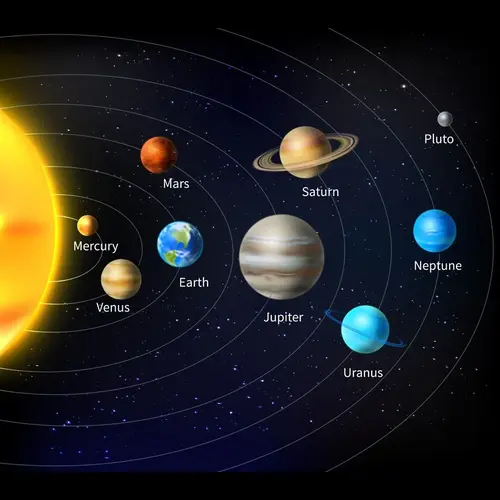This analysis examines Pluto, the outermost planet used in much of Western astrology, from the perspective of Jyotish (Vedic Astrology). Discovered in 1930, Pluto is not one of the nine traditional Grahas. We dissect the question of its relevance, exploring Pluto Sign Meaning (Western context) themes like Transformation, Power & Rebirth and comparing them to how Jyotish addresses similar concepts through its established framework. Key Jyotish factors like Shani (Saturn), Mangal (Mars), Rahu/Ketu, and the 8th Bhava (House) are central to understanding transformation within the Vedic system.
LENS 1: Traditional Foundation (The Traditional Jyotishi’s View)
Key Findings: Traditional Jyotish does not recognize or utilize Pluto. The system of nine Grahas (Surya to Shani plus Rahu and Ketu) is considered complete and sufficient for understanding all life events, including profound transformations, power dynamics, death/rebirth experiences, and subconscious forces. These themes are intrinsically woven into the functions of existing Grahas and Bhavas.
Detailed Analysis:
Classical Jyotish attributes themes associated with Pluto to several factors:
- Transformation, Death/Rebirth, Hidden Matters, Occult: Primarily governed by the 8th Bhava (Randhra Bhava – House of Mysteries/Transformation/Longevity) and its lord (8th Bhavapathi). Shani (Saturn) as the Karaka for death, longevity, loss, and chronic issues, and Ketu (detachment, endings, past lives, moksha) are also key.
- Power Dynamics, Control, Destruction: Related to Mangal (Mars – force, domination, destruction), Surya (Sun – authority, power), Rahu (obsession, manipulation, power struggles), and challenging Yogas indicating conflict or dominance.
- Subconscious Drives, Compulsions: Seen through Rahu (insatiable desire, compulsion), Chandra (mind, subconscious patterns), the 12th Bhava (subconscious, hidden self), and deeply embedded karmic patterns (samskaras) revealed by the overall chart and Dasha sequence.
- Expert Insight (Traditional Source): “The cycles of creation, preservation, and destruction, mirroring birth, life, and death, are inherent in the interplay of the nine Grahas under the law of Karma. The 8th Bhava, Shani, and Mangal hold particular keys to transformation and endings.” – Principle reflecting classical Jyotish understanding.
- Critical Considerations: To a traditional Jyotishi, attributing Plutonian themes to a non-traditional planet overlooks the profound depth and accuracy with which the existing Grahas, Bhavas (esp. 8th), and timing systems (Dashas) already delineate these intense life experiences.

LENS 2: Contemporary Interpretation Framework (The Modern Jyotishi’s Comparative Approach)
Key Findings: While respecting tradition, some contemporary Jyotishis engaged in comparative astrology might explore symbolic parallels between Pluto’s Western significations and Jyotish concepts. This is typically done for theoretical understanding or contextualizing collective trends, not for integrating Pluto into core Jyotish practice.
Detailed Analysis:
Modern comparative astrologers might note resonance between Pluto’s themes and Jyotish factors:
- Transformation/Rebirth: Compared to the intense transformations often seen during challenging Dasha periods (like Saturn Dasha or Rahu/Ketu periods), or related to the 8th house activation by transit or lordship. The concept of karmic cleansing or burning away dross relates to Shani’s purificatory role or Ketu’s detachment.
- Power Dynamics/Control: Explored through the lens of Raja Yogas (power), afflictions involving Surya (ego/authority) or Mangal (aggression/control), or Rahu’s capacity for manipulation and obsession. Astrology Power Dynamics are inherent in Graha relationships.
- Subconscious Drives/Secrets: Linked to the 12th house, Rahu/Ketu axis, hidden aspects of Chandra (mind), and the deeper layers of karma revealed through Varga charts. Where You Face Transformation Astrology is often pinpointed by the 8th house and Dasha cycles.
- Expert Insight (Modern Jyotishi – with caveat): “Observing Pluto’s discovery coinciding with the atomic age and deeper psychological exploration offers a symbolic parallel. In Jyotish, however, we find the intensity of transformation and power dynamics deeply explained by Shani’s pressure, Mangal’s force, Rahu/Ketu’s karmic axis, and the profound mysteries of the 8th house.” – Contemporary Jyotish practitioner emphasizing comparison.
- Critical Considerations: Mapping Pluto directly onto one Graha (like Saturn or Mars) is inaccurate, as Pluto’s Western meaning combines elements signified by multiple factors in Jyotish. The lack of defined dignities, aspects, or Dasha rulership makes Pluto unusable within the predictive and remedial framework of Jyotish.

LENS 3: Learning Path Analysis (The Student’s Perspective)
Key Findings: Jyotish students must prioritize learning how the traditional nine Grahas and twelve Bhavas comprehensively address themes of power, death, transformation, and the subconscious. Understanding the 8th house, Shani, Mangal, Rahu, and Ketu is essential before considering external comparisons.
Detailed Analysis:
The learning focus is internal to the Jyotish system:
- Mastering the significations of the 8th Bhava (longevity, death, inheritance, occult, transformation, chronic illness, obstacles).
- Understanding the roles of Shani (karma, discipline, time, endings, loss), Mangal (force, conflict, surgery, accidents), Rahu (obsession, sudden events, secrets), and Ketu (detachment, endings, liberation, subconscious patterns).
- Learning about Dusthana houses (6, 8, 12) and Yogas involving their lords.
- Grasping how Dasha periods (planetary cycles) activate transformative processes.
- Student Question: “If Pluto represents transformation, and Jyotish doesn’t use it, how does Jyotish explain major life upheavals?” Answer: Through multiple factors: the Dasha sequence activating challenging planets or houses (esp. the 8th); difficult transits (like Sade Sati – Saturn over Moon, or transits of Rahu/Ketu/Mars over sensitive points); Yogas indicating sudden changes; and the inherent nature of the 8th house and planets like Saturn, Mars, Rahu, and Ketu to bring about profound, often difficult, transformations as part of the karmic process.
- Expert Insight (Jyotish Student): “Learning about the 8th house in Jyotish was mind-blowing. It covers so many ‘Plutonian’ themes – death, secrets, transformation, occult – but ties it directly to karma and longevity in a way that feels much more integrated than just adding another planet.”
- Common Misconceptions vs. Reality: Misconception: Jyotish ignores deep psychological transformation because it doesn’t use Pluto. Reality: Jyotish has a sophisticated framework for understanding deep transformation through karma, the subconscious (12th house, Ketu), the process of destruction and renewal (8th house, Shani, Mangal), and the Dasha system. Misconception: You can just add Pluto to a Vedic chart. Reality: Doing so ignores the internal consistency and established rules of Jyotish interpretation, aspects, and timing.

LENS 4: Practical Implementation (The Jyotish Practitioner’s Focus)
Key Findings: Practical Jyotish consultations addressing transformation, power issues, crises, or subconscious blocks rely entirely on the analysis of the nine Grahas, twelve Bhavas (esp. 8th, 6th, 12th), relevant Vargas (like D8 Ashtamsa or D30 Trimshamsha for adversities), Yogas, and the Dasha/Gochar (transit) context. Pluto is not used for diagnosis or remedy.
Detailed Analysis:
When clients face transformative crises or power struggles:
- The 8th Bhava, its lord, and occupants are analyzed for the nature of transformation and obstacles.
- Shani’s position and influence reveal karmic lessons, discipline, and endurance needed.
- Mangal shows energy, conflict style, and potential for destructive/constructive force.
- Rahu/Ketu axis highlights areas of karmic imbalance, obsession, or necessary detachment driving the transformation.
- Dasha periods indicate the timing and planetary flavour of the upheaval.
- Appropriate Upayas (remedies) are suggested based on strengthening benefic influences or propitiating afflicted traditional Grahas (e.g., Shani or Mangal mantras, Rudraksha, specific charities).
- Technique Deep Dive: Ashtakavarga Analysis: This complex system assesses the strength of each Graha and Bhava based on planetary positions relative to each other, providing nuanced insights into inherent strengths/weaknesses related to longevity, crisis management (8th house strength), and overall vitality, guiding practical advice during transformative periods.
- Expert Insight (Jyotish Consultant): “Themes of deep transformation and power are central to many consultations. Jyotish provides precise tools – the 8th house, Saturn, Mars, Rahu/Ketu, Dashas – to understand the root cause, timing, and karmic purpose of these experiences, and to offer appropriate Vedic remedies. We don’t need Pluto to navigate these profound waters.
PERSPECTIVE INTEGRATION MATRIX
| Feature | Western Pluto Theme | Vedic Jyotish Factors Addressing Theme | Student Focus | Practical Jyotish Use | Integration Point |
| Transformation | Pluto | 8th Bhava/Lord, Shani, Ketu, Mangal, Dashas, Transits | Master 8th House, Shani, Ketu roles | Diagnose crisis nature/timing, suggest Upayas | Jyotish factors provide specific karmic context & timing for transformation. |
| Power/Control | Pluto | Surya, Mangal, Rahu, Raja Yogas, Shadbala | Understand Graha strength/dominance | Assess leadership/conflict style, guide | Jyotish assesses power dynamics through planetary strength & interactions. |
| Death/Rebirth | Pluto | 8th Bhava/Lord, Shani (Longevity/Death Karaka), Ketu (Endings/Moksha) | Learn Longevity factors, Moksha | Assess health/longevity concerns | Jyotish links death/rebirth to specific houses, Karakas, and the broader karmic cycle. |
| Subconscious/Obsession | Pluto | 12th Bhava, Chandra, Rahu (Obsession), Ketu (Subconscious patterns) | Differentiate Chandra/Rahu/Ketu | Address compulsions/fears, trace karma | Jyotish addresses subconscious via mind (Chandra), karma (Ketu), obsession (Rahu), hidden self (12th). |
MISCONCEPTION ANALYSIS
| Common Belief | Jyotish Reality |
| Jyotish needs Pluto for depth psychology. | Jyotish has its own profound system for understanding the subconscious, transformation, and karmic complexes through its existing Grahas, Bhavas, Vargas, and Dashas. |
| Pluto’s discovery changed astrological truth. | Traditional Jyotish considers its principles timeless and revealed, unaffected by discoveries within the material world (Maya). The system remains complete. |
| You can easily map Pluto onto Saturn or Mars. | Pluto’s Western themes overlap partially with multiple Jyotish factors (Shani, Mangal, 8th House, Rahu/Ketu); a direct one-to-one mapping is inaccurate and reductionist. |
| Modern Jyotish widely uses outer planets. | While some individuals experiment or do comparative studies, the vast majority of reputable Jyotish practitioners adhere strictly to the nine traditional Grahas. |
KEY DEVELOPMENTS & FUTURE DIRECTIONS (Evolution Timeline – Comparative)
- Classical/Medieval Jyotish: System based on 9 Grahas fully developed, addressing all life themes including transformation and power.
- 1930: Pluto discovered. Western astrology begins incorporating it, developing interpretations over decades.
- Late 20th/21st Century: Increased cross-cultural exchange. Some Western-influenced or comparative astrologers discuss Pluto in relation to Jyotish, but it does not gain acceptance within the traditional Jyotish framework or methodology. Debate continues primarily outside mainstream Jyotish practice.
- Future: Traditional Jyotish will likely continue to rely on its established nine Grahas. Comparative studies may continue, but practical application within Jyotish is unlikely to incorporate Pluto due to systemic incompatibility. The focus remains on deepening the understanding of the existing, profound tools of Jyotish.
SYNTHESIS & RECOMMENDATIONS (Celestial Integration – Acknowledging Boundaries)
Pluto, a powerful archetype in Western astrology, remains outside the traditional boundaries of Jyotish. Integrating perspectives means recognizing that Jyotish addresses themes of Transformation, Power & Rebirth comprehensively through its own sophisticated system involving the 8th Bhava, Shani, Mangal, Rahu, Ketu, and the Dasha system (Traditional/Practical). Students should prioritize mastering these core Jyotish concepts (Student). Comparative analysis can be an intellectual exercise but should not replace or dilute authentic Jyotish practice (Contemporary Exploration vs. Tradition).
Recommendations:
- Focus on Jyotish Factors: To understand transformation, power, death/rebirth themes in your life through Jyotish, deeply analyze your 8th House, its lord, Shani, Mangal, Rahu, and Ketu placements and strengths.
- Study Dasha Timing: Major life transformations are often clearly indicated by the activation of relevant Dasha periods.
- Understand the 8th House: Delve into the multifaceted nature of the 8th Bhava – it’s not just negative; it’s the house of profound change and hidden knowledge.
- Respect System Integrity: Avoid casually inserting Pluto into Jyotish interpretations, as it lacks the necessary framework (dignities, aspects, lordship, Dasha) to function meaningfully within the system.
- Seek Authentic Guidance: Consult qualified Jyotish practitioners who work within the traditional framework for accurate insights and remedies related to transformative experiences.
FURTHER AREAS OF STUDY
- Rahu and Ketu (The Nodes) Explained in Jyotish
- Shani (Saturn) in Jyotish: Structure, Limits & Responsibility
- Mangal (Mars) in Jyotish: Action, Drive & Desire
- The Significance of Bhavas (Houses) in Jyotish (esp. 8th, 6th, 12th – Dusthanas)
- Understanding Dasha Systems in Vedic Astrology









